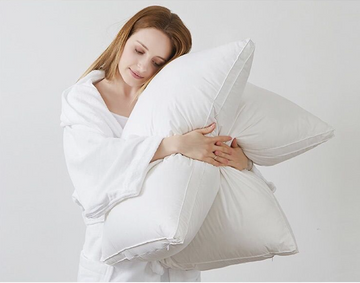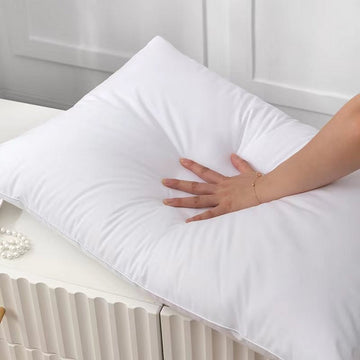Understanding Feather Pillows: Types and Benefits
Types of Feather Pillows and Differences
Finding the perfect pillow can be a game-changer for sleep quality. Let's explore the various types of feather pillows and their key differences. Generally, feather pillows fall into two categories: those filled with pure feathers and those that combine feathers with down. Pure feather pillows are known for their support, as the feathers are firmer than down. These pillows typically last longer due to the resilience of the feathers. Mixed feather-down pillows, on the other hand, offer a softer feel and allow for more sinkage, as down clusters are softer and fluffier. Users can choose based on desired firmness and support levels. Such variety ensures that there's a feather pillow to suit every sleeper's preference, ensuring a customized sleep experience.
The Unique Benefits of Feather Pillows for Sleep Quality
feather pillows have unique benefits that boost sleep quality. They mold to your head's shape. This provides custom support and eases pressure points. Alongside this, feather pillows offer superior breathability. They keep you cool all night by allowing air to circulate. Feather pillows are durable too. With care, they can last several years, outlasting foam or synthetic fills. They're also soft and fluffy. This makes them feel comfortable and luxurious to sleep on.
Identifying High-Quality Feathers: What to Look For
When seeking high-quality feather pillows, there are key features to consider. Look for a high fill power, which means more fluff and better support. Ensure the feathers are of top grade, avoiding those with sharp quills that can pierce fabric. Choose pillows with a down-proof cover to prevent feathers from escaping. Check for certifications like the Responsible Down Standard (RDS) that assure ethical sourcing. Lastly, a good quality ticking with high thread count enhances durability and comfort.
The Role of Feather Pillows in Sleep Health
How Feather Pillows Affect Neck Alignment and Comfort
feather pillows play a critical role in sleep health, one of which is ensuring proper neck alignment. These pillows adapt to the shape of your head and neck. This provides tailored support and helps prevent stiffness. By adequately supporting the cervical spine, they promote a comfortable posture. As a result, you wake up feeling refreshed and without discomfort. It's essential to choose the right firmness to match your sleeping position for optimal benefits. Side sleepers often need a firmer pillow. Back and stomach sleepers may prefer a softer one. Always aim for the sweet spot where comfort meets support to enhance neck alignment and overall sleep health.
The Impact of Pillow Choice on Sleep Patterns and Restfulness
The right pillow can make a huge difference in the quality of your sleep. feather pillows, known for their softness and ability to conform to your head, play an important role in your sleep cycle. When your head and neck are comfortably supported, you're less likely to toss and turn. This means you can fall into a deeper, more restful sleep. As a result, you might find that you wake up less often during the night and feel more refreshed in the morning. Choosing a feather pillow could be the key to unlocking a more consistent and peaceful sleep pattern.
Feather Pillows vs. Other Materials: A Comparative Study
When it comes to sleep quality, the choice of pillow is key. Let's compare feather pillows with other materials. Memory foam is popular but can retain heat, resulting in discomfort. Polyester pillows may be less expensive but often lack the durability and comfort of feathers. Latex pillows provide support, but they might be too firm for some sleepers. Down alternatives cater to allergies but may flatten easily over time. feather pillows, however, offer a unique combination of support and softness. They conform to your head and neck, yet spring back to shape. They're also breathable, meaning less night sweating. By contrast, each material has its pros and cons. But feathers are often seen as the gold standard for a reason. They balance comfort, support, and durability better than most. In the quest for a good night's rest, a feather pillow could be a wise investment.
Care and Maintenance for Lasting Comfort
Proper Cleaning Techniques for Feather Pillows
Taking care of feather pillows ensures they last longer and stay comfortable. Here's how to clean them right. First, check the pillow's label for specific care instructions. Use a mild detergent and cold water for washing. Hand wash gently or use a washing machine on a delicate cycle. Avoid using bleach, which can damage the feathers. To dry, lay the pillow flat or tumble dry on low heat with dryer balls. Dry it completely to prevent mold. Lastly, fluff it regularly to maintain its shape. Follow these steps for fresh, fluffy pillows ready for restful nights.
Tips for Prolonging the Life of Your Feather Pillow
To extend their lifespan, handle feather pillows with care. Fluff them daily to maintain shape. Use pillow protectors to shield from oils and dirt. Avoid exposure to moisture, as it can harm feathers. Keep them away from direct heat sources like radiators. It prevents drying out the natural oils. Rotate pillows regularly to distribute wear evenly. Follow the specific wash care instructions. Most feather pillows should be washed seldom. Choose a mild detergent and avoid harsh chemicals. Ensure pillows are fully dry before use to avoid mildew. By caring for your feather pillows, you ensure restful sleep for years to come.
When to Replace: Recognizing Signs of Wear in Feather Pillows
feather pillows offer cozy sleep but wear out over time. It's vital to know when to replace them. Look for signs like lumps or a decrease in support. Also, if you spot feathers poking through the cover frequently, it's a hint. Another clue is the pillow's age. Most need replacing every 1-3 years. If allergies flare up, the pillow might be to blame. Last, do the fold test. Fold the pillow in half. If it doesn't spring back, it's time for a new one.







